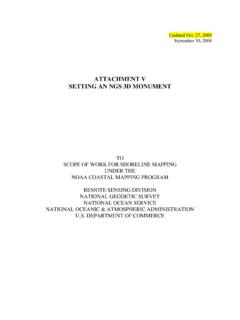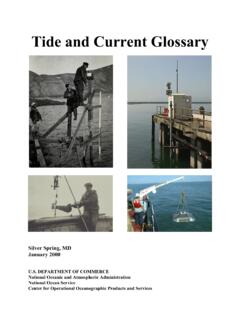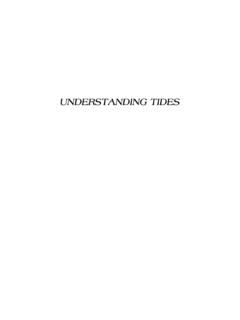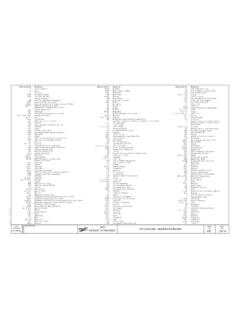Transcription of User’s Guide to Vertical Control and Geodetic Leveling for ...
1 User s Guide to Vertical Control and Geodetic Leveling for CO-OPS Observing Systems by Minilek Hailegeberel, Kirk Glassmire, Artara Johnson, Manoj Samant, and Gregory Dusek Center for Operational Oceanographic Products and Services Silver Spring, MD May 2018 Acknowledgements Major portions of the publications of Steacy D. Hicks, Philip C. Morris, Harry A. Lippincott, and Michael C. O'Hargan have been included as well as from the older publication by Ralph M. Berry, John D. Bossler, Richard P. Floyd, and Christine M. Schomaker. These portions are both direct or adapted, and cited or inferred.
2 Complete references to these publications are listed at the end of this document. A CO-OPS Vertical Control Committee was created in 2017 to update, with current practices, the 1984 Users Guide for Installation of Bench Marks. The committee met on a bi-weekly basis to document current practices and procedures for installing and surveying of bench marks. Through many months of collaborative efforts with National Geospatial Survey, the committee provided their input into this Guide . The committee s participation in writing this document is greatly appreciated. Vertical Control Committee Group Members Artara Johnson (CO-OPS) Dan Roman (NGS) Gregory Dusek (CO-OPS) Jeff Oyler (CO-OPS) John Stepnowski (CO-OPS) Kirk Glassmire (CO-OPS) Laura Rear McLaughlin (CO-OPS) Manoj Samant (CO-OPS) Mark Bailey (CO-OPS) Michael Michalski (CO-OPS) Peter Stone (CO-OPS) Philippe Hensel (NGS) Rick Foote (NGS) Robert Loesch (CO-OPS) Ryan Hippenstiel (NGS) The authors are especially grateful for Manoj Samant and Gregory Dusek for providing content as well as providing numerous edits into this Guide .
3 In addition, CO-OPS is thankful for NGS Philippe Hensel for making himself available to provide great insight into bench mark surveying. Table of Contents Chapter 1 Preface 1 Introduction 1 Purpose 1 Tidal Epochs and Reference Epochs 2 Datums 2 Primary water Level Sensors 3 Bench Mark Networks 3 Chapter 2 - Bench Marks 4 Definition 4 Types of Bench Marks 5 Class A Bench Marks 7 Bench Mark Disks Set in Bedrock 7 Bench Marks in Large Structures with Bedrock Foundations 8 Class B Bench Marks 8 Stainless Steel Deep Rod Bench Marks (3D) 8 Thermopile Bench Marks 9 Bench Mark Disks in Large Man-Made Structures 10 Class C Bench Marks 10 Concrete Monuments 10 Bench Mark Disks on Pipes 12 Bench Mark Disks set in Medium Structures or Small Buildings 13 Class D Bench Marks 13 Temporary Bench Marks 14 Sensor Leveling Point 14 Staff 18 Electric Tape Gauge 18 Meteorological Standard Reference Marks (MET SRM)
4 19 General Guidelines and Best Practices - Mark Placement 20 Spacing and Proximity Requirements 20 Bench Marks in a Single Structure 21 GPS Observable Marks 21 Frost Penetration 23 Primary Bench Mark (PBM) 23 Vertical Stability 24 Numbering Bench Marks 25 General Naming Conventions 25 Resetting Bench Marks 26 Bench Mark Descriptions, Recovery Notes, Photos 26 To Reach Statement 27 Bench Mark Diagram 27 Bench Mark Recovery 29 Bench Mark Photographs 30 Bench Mark Descriptions 30 Unstable Marks and Removal of Bench Marks from Network 31 water Level Station Types and Required Number of Bench Marks 32 Long Term Station 32 Short Term Station 32 Chapter 3 - Leveling 33 Standards and Specifications for Leveling 33 Vertical Stability Precautions 34 Frequency of Leveling 35 Instruments 36 Sources of Leveling Error 39 Curvature 39 Refraction 40 Eliminating error due to Curvature and Refraction 41 Leveling Collimation
5 Error 41 Collimation Check 42 Standard of accuracy for collimation error 43 Collimation error 43 General instruction for the collimation check 44 Kukkamaki method 44 10-40 method 47 Compensation check 50 General Observing Routine 50 Parallax 50 Balanced Sights 50 Sight Length 51 Atmospheric Conditions 51 Closure Tolerance 52 Cumulative Closure 52 Leveling Procedures to the Reading Mark (RM) of the Electric Tape Gage (ETG) 53 Field Records and Computations 54 Abstract of precise Leveling 54 Use of Collapsible Rods 55 Tabulation and Computation of Third-order Levels 56 Closure Tolerance 56 Closure procedure 57 Rejection procedure 57 Special Cases.
6 water Crossings, Precise Reciprocal Leveling , and Unbalanced Sights 58 water Crossings 58 Precise Reciprocal Leveling 59 Unbalanced Sights 60 Trigonometric Leveling 61 Chapter 4 - GPS 62 References 63 1 Chapter 1 Preface Introduction The National Ocean Service (NOS) Center for Operational Oceanographic Products and Services (CO-OPS) is responsible for the management of a national water level measurement program. The foundation of this program is the operation and maintenance of the National water Level Observation Network (NWLON), a network of approximately 200 continuously operating data collection stations in the coastal oceans, the Great Lakes and connecting waterways, and in Trust Territories and Possessions.
7 The data and information from this network represent one of the most unique and valuable geophysical data sets available. The network provides for the determination and maintenance of Vertical reference datums used for surveying and mapping, dredging, coastal construction and restoration, water level regulation, marine boundary determinations, tide prediction, and determination of long-term water level variations ( trends). The station platforms and telemetered data are used to support major Government programs such as the NWS Tsunami Warning System, the NWS storm surge monitoring programs, the Army Corps of Engineers (USACE) national dredging program, the USACE/Canadian Great Lakes regulation program, and the NOAA Climate and Global Change Program.
8 This Guide provides references to several National Geodetic Survey (NGS) documents related to the standard methodologies and tools used to derive Geodetic elevations using differential and trigonometric Leveling . These references do not supersede the information in this document as this document is specifically written to determine and monitor water level sensor and bench mark network elevations for the determination of tidal datums and subsequently the sea level trend. Purpose Vertical Control at a water level station enables the establishment and continuity of tidal and water level datums over time, regardless of any change in sensors.
9 This is accomplished through an array of locally established permanent bench marks which are the foundation of a water level station's Vertical Control network. Through this established network, differential and trigonometric Geodetic Leveling can be used to establish precise and accurate height differences between each bench mark and each sensor. Therefore, datums can be maintained at the tide station over time even in the event that the sensors or bench marks are destroyed by coastal storms or other phenomena. The purpose of this document is to provide guidance and list specifications for monitoring and documenting the associated metadata pertaining to the stability of the water level sensor(s) and the associated bench mark network via differential Geodetic and trigonometric Leveling and/or static GPS observations.
10 Documenting the stability of the water level sensor(s) and of the bench mark network, provides great confidence in the accuracy of the data collected and that it is free of bias via Vertical land motion or movement from the structure of which the water level sensor is mounted on. Therefore, frequent Leveling to the bench mark network and water level sensor(s) aids in documenting Vertical land motion as well as the movement of the water level sensor(s). 2 A known source of land movement is regional Vertical land motion. This motion is attributed to phenomena such as glacial isostatic adjustment, uplift, subsidence, and erosion.






